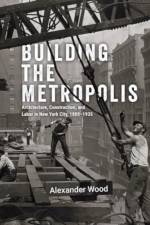- Architecture, Construction, and Labor in New York City, 1880-1935
av Alexander Wood
437
A sweeping history of New York's urban development that chronicles the making of one of the world's great cities. Between the 1880s and the 1930s, New York City experienced explosive growth, as nearly a million buildings, half a dozen bridges, countless tunnels and subway tracks, and miles of new streets and sidewalks were erected to meet the needs of an ever-swelling population. This landscape--jagged with skyscrapers, clamoring with transit, alive with people--made the city world-famous. Building the Metropolis offers a revelatory look at this era of urban development by asking, "Who built this and how?" Focusing on the work of architects, builders, and construction workers, Alexander Wood chronicles the physical process of New York's rapid expansion. The city's towering buildings and busy thoroughfares aren't just stylish or structural marvels, Wood shows, but the direct result of the many colorful personalities who worked in one of the city's largest industries. New York's development boom drew on the resources of the whole community and required money, political will, creative vision, entrepreneurial drive, skilled workmanship, and hard physical labor. Wood shows this to be a national story as well. As cities became nodes in a regional, national, and global economy, the business of construction became an important motor of economic, political, and social development. While they held drastically different views on the course of urban growth, machine politicians, reformers, and radicals alike were all committed to city-building on an epic scale. Drawing on various sources, including city archives, the records of architecture firms, construction companies, and labor unions, Building the Metropolis tells the story of New York in a way that's epic, lively, and utterly original.







